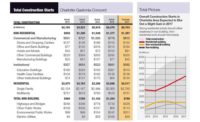Charlotte's eight-year-old LYNX Blue Line, which attracts more than 15,500 daily riders and has spurred $1.45 billion in development within a half-mile of its 9.6-mile corridor, is frequently touted as a model for cities interested in developing light rail transit systems.
A $1.2-billion, 9.3-mile extension of the Blue Lines is two years away from its fall 2017 start-up date, but it serves as an example of the perseverance necessary to overcome the complex, interrelated challenges of constructing linear infrastructure systems in urban environments.
For instance, to connect the existing Blue Line's Uptown terminus with the University of North Carolina-Charlotte (UNCC) campus to the northeast, the extension's dual tracks, 11 stations and other facilities are being wedged into some of the city's busiest road and freight rail corridors.
Those constraints presented the Charlotte Area Transit System (CATS) with the challenges of extensive utility relocations, coordinating work with long-haul train schedules and developing strategies to preserve access to dozens of businesses along the route during the four-year construction phase.
Due to the current complexities facing the project team, CATS project director Danny Rogers says experience gained from having built more than 11 miles of light rail citywide went only so far.
"This is a different corridor," Rogers says.
That fact was made clear as construction got underway in early 2014 with the task of identifying and coordinating the relocation of "an astronomical number" of above- and below-ground utilities, says Troy Carter, senior project manager for Lane Construction Corp., Cheshire, Conn. The firm is handling civil construction work at a cost of $119 million for segments B and C, which total 4.9 miles. A joint venture of Balfour Beatty Infrastructure, Atlanta, and Blythe Development, Charlotte, is handling the 4.5-mile-long segment A under a $108-million contract.
Additionally, Balfour Beatty holds a $130.8-million contract to build the track and related systems. That contract includes $114.4 million for the new line and $16.4 million for platform and system extensions on the original line.
Before contractors could widen a 4.15-mile stretch of four-lane Tryon Avenue-long one of Charlotte's main through routes-in order to accommodate the Blue Line Extension's 40-ft-wide right-of-way, dozens of utility poles and numerous underground telecommunication and infrastructure lines buried up to 15 ft deep needed to be moved to create sufficient subterranean space for a new storm drainage network and the widened roadway.
Coordinating that work to keep traffic flowing as smoothly as possible would have been difficult enough, Rogers says. But because the individual utilities bore the cost of the relocations, the response tended to be slower than CATS desired.
"The incentive for them to work quickly wasn't as strong as if they were being paid to do it," Rogers says.








Post a comment to this article
Report Abusive Comment